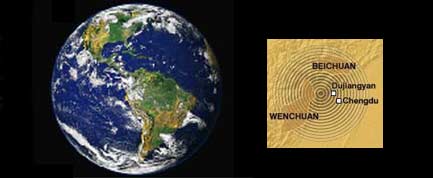Big Quakes Trigger Global Shaking

The giant earthquake that unleashed the Indian Ocean tsunamis in 2004 — killing more than 225,000 people in one of the deadliest natural disasters in history — might also have triggered other quakes around the world, new findings reveal.
The earthquake that ravaged China last week may also have set off other quakes around the globe, but that data has not been analyzed yet. But the new research shows that major earthquakes may routinely set off smaller jolts, even on the opposite side of the planet and in areas not prone to quakes.
Earthquakes rank among the most destructive events on the planet. The 2004 Indian Ocean quake was magnitude 9.3, unleashing some 1.3 billion tons of TNT's worth of energy, said researcher Aaron Velasco, a seismologist at the University of Texas at El Paso. That is the equivalent of nearly 100,000 Hiroshima bombs, making it the second largest quake ever recorded with instruments.
And the effects of earthquakes can be felt far and wide. The earthquake that just hit China, a magnitude 7.9, shook buildings in Shanghai at least 1,000 miles away from its epicenter in Sichuan.
New thinking
Until recently, scientists did not think major earthquakes set off smaller tremors at distant locations. Then, in 1992, they found that California’s magnitude-7.3 Landers earthquake set off small jolts as far away as Yellowstone National Park.
While the 1992 findings suggested earthquakes could trigger smaller quakes nearby, how far major earthquakes could reach was a mystery. To investigate further, scientists analyzed 15 earthquakes of magnitude 7 or greater that occurred since 1990. These included the 2004 Indian Ocean earthquake, as well as the 1999 Izmit earthquake in Turkey that killed at least 15,000 and left a half-million homeless.
Get the world’s most fascinating discoveries delivered straight to your inbox.
By studying rumbles in the ground five hours before and five hours after these earthquakes — data gathered from more than 500 research stations worldwide — the researchers found that 12 of these large earthquakes generated surface waves that set off quakes around the planet. For instance, the 2004 Indian Ocean earthquake triggered small earthquakes as far away as Alaska, California and Ecuador.
There are normally about 600 small seismic events around the Earth every five minutes, and after major quakes, the researchers found that on average, more than twice the normal number of small earthquakes occurred. Some quakes triggered far more rumbles than this average — after the 2004 Indian Ocean earthquake, there were roughly 2,400 more small quakes detected than normal.
Specifically, the researchers found that surface waves from major quakes can often trigger magnitude 4 or smaller earthquakes.
More to learn
There are two kinds of surface waves earthquakes generate — Love waves, which move in a shearing fashion, and Rayleigh waves, which have a rolling motion.
Much about earthquakes is still mysterious, however, and it remains unknown how exactly these surface waves trigger smaller quakes at distant locations.
"The passage of the waves may change the water flow in a fault, possibly increasing the number of conduits that water can flow through which could cause the fault to slip," said researcher Kris Pankow, a seismologist at the University of Utah. Surface waves might also increase the strain on a fault, or loosen a fault so that it prematurely breaks or slides, she adds.
When the Sichuan quake happened, "we analyzed data from the continental U.S. over 300 stations," Velasco told LiveScience. Surprisingly, they found no significant increase in rumbles due to the Chinese quake. Of course, other stations around the world might have detected quakes, data that have not been analyzed yet, he added. Alternatively, perhaps the Sichuan quake may not have sent much out in terms of surface waves.
One question now is "do large quakes trigger other large quakes?" Velasco said. "Probably not. But we really need to better understand how stresses from these earthquakes are doing the triggering, the dynamics of what's happening."
Velasco, Pankow and their colleagues Tom Parsons and Stephen Hernandez detailed their findings online May 25 in the journal Nature Geoscience. The study was funded by the United States Geological Survey and the National Science Foundation.
- Video: Earthquake Forecast
- The Worst Natural Disasters Ever
- Deadliest Earthquakes in History

